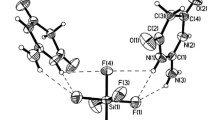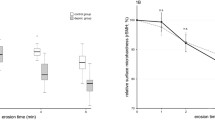Summary
Inhibition of calcium phosphate precipitation in saliva, and prevention of the formation of mineral accretions on tooth surfaces, has been ascribed to the existence of inhibiting salivary macromolecules. Marked reductions in the crystal growth rate of hydroxyapatite (HA) seeds were measured in supersaturated solutions containing either of two proline-rich proteins, PRP1 or PRP3, or statherin; the three macromolecules were isolated from human parotid saliva. The reductions were also observed when the HA seeds were pretreated with solutions of the macromolecules before adding them to the supersaturated calcium phosphate solution. This effect was very similar in the case of the two PRPs and it was directly related to the extent of adsorption site coverage of these proteins on the HA seeds. The effect of statherin was larger than anticipated from its adsorption behavior. However, comparison on the basis of number of moles adsorbed per unit area of HA shows that the PRP are more effective inhibitors than statherin. The macromolecule concentrations used were considerably lower than those in the salivery secretions, therefore these macromolecules could readily prevent mineral accretion on tooth surfaces through their adsorption onto the enamel surface.
Similar content being viewed by others
References
McCann, H.: The inorganic components of salivary secretions. In R. Harris (ed.): Art and Science of Dental Caries Research. Academic Press, New York, 1968
Grøn, P.: Saturation of human saliva with calcium phosphates, Arch. Oral Biol.18:1385–1392, 1973
Grøn, P.: The state of calcium and inorganic orthophosphate in human saliva, Arch. Oral Biol.18:1365–1378, 1973
Tomazic, B., Tomson, M., Nancollas, G.H.: The growth of calcium phosphates on natural enamel, Calcif. Tissue Res.19:263–271, 1976
Grøn, P., Hay, D.I.: Inhibition of calcium phosphate precipitation by human salivary secretions, Arch. Oral Biol.21:201–205, 1976
Hay, D.I., Schlesinger, D.H.: Human salivary statherin. A peptide inhibitor of calcium phosphate precipitation. In R. Wasserman et al. (eds.): Calcium Binding Proteins and Calcium Function, pp. 401–408, North Holland, New York, 1977
Schlesinger, D.H., Hay, D.I.: Complete covalent structure of statherin, a tyrosine-rich acidic peptide which inhibits calcium phosphate precipitation from human parotid saliva, J. Biol. Chem.252:1689–1695, 1977
Oppenheim, F.G., Hay, D.I., Franzblau, C.: Proline-rich proteins from human partoid saliva, Biochemistry10:4233–4238, 1971
Bennick, A., Connell, G.E.: Purification and partial characterization of four proteins from human parotid saliva, Biochem. J.123:455–464, 1971
Hay, D.I.: The isolation from human parotid saliva of a tyrosine-rich acidic peptide which exhibits high affinity for hydroxyapatite surfaces, Arch. Oral Biol.18:1531–1541, 1973
Bennick, A., Wong, R., Cannon, M.: Structure and biological activities of salivary acidic proline rich phosphoproteins. In R. Wasserman et al. (eds.): Proc. Int. Symp. on Calciumbinding Proteins and Calcium Function in Health and Disease, pp. 391–400. North-Holland, New York, 1977
Moreno, E.C., Zahradnik, R.T., Glazman, A., Hwu, R.: Precipitation of hydroxyapatite from dilute solutions upon seeding, Calcif. Tissue Res.24:47–57, 1977
Moreno, E.C., Kresak, M., Hay, D.I.: Adsorption of two human parotid salivary macromolecules on hydroxy-, fluorhydroxy- and fluorapatites, Arch. Oral Biol.23:525–533, 1978
Bennick, A.: Chemical and physical characterization of a phosphoprotein, protein C, from human saliva and comparison with a related protein A, Biochem. J.163:229–239, 1977
Vogel, A.I.: Quantitative Inorganic Analysis, 3rd Ed., p. 810. John Wiley & Sons, New York, 1961
Lowry, O.H., Roseborough, N.J., Farr, A.L., Randall, R.J.: Protein measurement with the Folin phenol reagent, J. Biol. Chem.193:265–275, 1951
Kresak, M., Moreno, E.C., Hay, D.I.: Adsorption of a proline-rich salivary protein and its purified amino-terminal tryptic fragment onto hydroxyapatite, J. Dent. Res.57, Special issue A, abst. 837, 1978
Schlesinger, D.H., Jacobs, R., Hay, D.I.: Primary structure of protein inhibitors of calcium phosphate precipitation from human salivary secretions. In M. Goodman and J. Meierhofer (eds.): Peptides. Proc. 5th American Peptide Symposium, pp. 56–58. Halsted Press, John Wiley & Sons, New York, 1977
Hay, D.I., Moreno, E.C.: Macromolecular inhibitors of calcium phosphate precipitation in human saliva. Their role in providing a protective environment for the teeth. Proc. Int. Symp. on Role of Salivary Constituents in Dental Caries. Stony Brook, N.Y. (in press)
Meyer, J.L., Nancollas, G.H.: The influence of multidentate organic phosphonates on the crystal growth of hydroxyapatite, Calcif. Tissue Res.13:295–303, 1973
Jung, A., Bisaz, S., Fleisch, H.: The binding of pyrophosphate and two diphosphonates by hydroxyapatite crystals, Calcif. Tissue Res.11:269–280, 1973
Robertson, W.G.: Factors affecting the precipitation of calcium phosphatein vitro, Calcif. Tissue Res.11:311–322, 1973
Meyer, J.L., McCall, J.T., Smith, L.H.: Inhibition of calcium phosphate crystallization by nucleoside phosphates, Calcif. Tissue Res.15:287–293, 1974
Kresak, M., Moreno, E.C., Zahradnik, R.T., Hay, D.I.: Adsorption of amino acids on to hydroxyapatite, J. Colloid Interface Sci.59:283–292, 1977
Miura, M., Naono, H.: The effect of several condensed phosphates on the dissolution of strontium sulfate, Bull. Chem. Soc. Jpn.38:494–495, 1965
Posner, A.S., Betts, F., Blumenthal, N.C.: Role of ATP and Mg in the stabilization of biological and synthetic amorphous calcium phosphates, Calcif. Tissue Res. Suppl.22:208–212, 1976
Author information
Authors and Affiliations
Rights and permissions
About this article
Cite this article
Moreno, E.C., Varughese, K. & Hay, D.I. Effect of human salivary proteins on the precipitation kinetics of calcium phosphate. Calcif Tissue Int 28, 7–16 (1979). https://doi.org/10.1007/BF02441212
Received:
Revised:
Accepted:
Issue Date:
DOI: https://doi.org/10.1007/BF02441212




